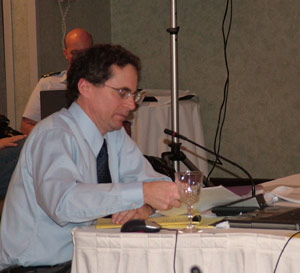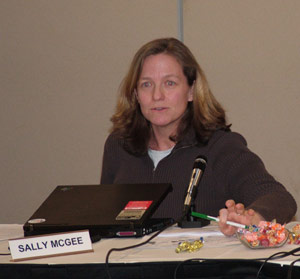 AIt’s difficult to develop effort control measures when you don’t know how much mortality change you’re trying to target. It’s difficult to tell whether those mortality reductions are enough – or too much. We don’t know what we don’t know.” —NEFMC fishery analyst Tom Nies. Fishermen's Voice photo AIt’s difficult to develop effort control measures when you don’t know how much mortality change you’re trying to target. It’s difficult to tell whether those mortality reductions are enough – or too much. We don’t know what we don’t know.” —NEFMC fishery analyst Tom Nies. Fishermen's Voice photo
|
Sector management is part of Amendment 16 to the Groundfish Management Plan. The system will allow groups of fishermen to enter into contractual agreements and operate with a limited number of pounds available for harvest. NEFMC would set each sector’s total allowable catch to ensure conservation goals were accomplished while allowing each sector to develop its own set of rules. Sectors will be required to report landings and discards, and will develop operations plans that outline how the sector will provide monitoring. Vessels not in a sector will remain in a common pool which will fish under the days-at-sea system.
Before NEFMC decided to postpone implementation, they worked on a number of sector issues, such as how the resource would be allocated among sectors, how landings and discards would be monitored, and how sectors would participate in existing special management programs.
There are two existing sectors requesting modifications—the Georges Bank Cod Hook Sector and the Fixed Gear Sector.
Seventeen new sectors have been proposed: * Sustainable Harvest Sector, to be established with the Portland Fish Exchange, more than 60 vessels, to fish in all management areas and with all allowed gear.
• Port Clyde Community Groundfish Sector, proposed by the Port Clyde Draggermen’s Co-Op and the Midcoast Fishermen’s Association, more than 10 vessels expected,requested allocations for Gulf of Maine stocks, to operate in statistical areas 511-515, using primarily trawl gear.
• New Bedford Deep Water Trawl Sector, 10 to 60 medium to large trawl vessels, primarily on Georges Bank or Southern New England.
• New Bedford and Southern New England Fixed Gear Sector, 10 to 60 vessels using gillnets or longlines, primarily on Georges Bank and the Gulf of Maine but also in Southern New England.
• New Bedford Channel Trawl Sector, 10 to 60 medium to large trawl vessels, primarily on Georges Bank and in Southern New England.
• New Hampshire and Southern Maine Fixed Gear Sector, 10 to 60 small to medium gillnet and longline vessels, primarily in the Gulf of Maine.
 “(But) if people want to take that risk, who are we to say, ‘No, you can’t take that risk.’” —Sally McGee, NEFMC Fishermen's Voice photo “(But) if people want to take that risk, who are we to say, ‘No, you can’t take that risk.’” —Sally McGee, NEFMC Fishermen's Voice photo
|
• New Hampshire and Southern Maine Trawl Sector, 10 to 60 small to medium bottom trawl vessels, primarily in the Gulf of Maine.
• Gloucester Trawl/Western Gulf of Maine Sector, 10 to 60 bottom trawl vessels from 36 to 70 feet in length, primarily in the Gulf of Maine.
• Gloucester Fixed Gear Sector, 10 to 60 small day and trip gillnet vessels and hook vessels, primarily in the Gulf of Maine.
• Gloucester/Boston Trawl Gulf of Maine and Georges Bank Sector, 10 to 60 bottom trawl vessels from 55-95 feet in length, primarily in the Gulf of Maine and Georges Bank.
• South Shore Trawl Sector, 10 to 60 small to medium bottom trawl vessels, primarily in the Gulf of Maine.
• South Shore Fixed gear Sector, 10 to 60 small to medium gillnet and hook vessels, primarily in the Gulf of Maine.
• Point Judith and Southern New England Offshore Trawl Sector, 10 to 60 medium to large trawl vessels, primarily on Georges Bank and in Southern New England.
• Point Judith and Southern New England Trawl Sector, 10 to 60 small and medium trawl vessels, primarily in Southern New England.
• Tri-State Sector, working with the Cape Cod Commercial Hook Sector, all management areas using all legal gear.
• Pier 6 Initiative, based in Boston, no details.
• Martha’s Vineyard Sector
A sector is proposed based in Martha’s Vineyard, interested in using regulatory discards to stock a cod hatchery, cod would be released in areas protected by closures in attempt to increase cod stocks near the island.
National Marine Fisheries Service regional administrator Pat Kurkul called NEFMC’s work on sector issues at this month’s meeting a waste of time, given the implementation realities and given the importance of other issues, such as the development of annual catch limits and accountability measures, as required by federal law. But other NEFMC members said the work needed to be done, and agreed to retain the proposed sectors and management provisions currently in A16.
A16 is also aimed at fleshing out annual catch limits and accountability measures.
“It’s difficult to develop effort control measures when you don’t know how much mortality change you’re trying to target,” said NEFMC fishery analyst Tom Nies. NEFMC is developing effort controls to use toward Amendment 13’s 2009 goals. It’s difficult to tell whether those mortality reductions are enough – or too much, Nies said. “We don’t know what we don’t know,” Nies said.
A13 targets represent huge reductions, Nies said.
“They’ll look really ugly and we don’t know if they have any basis in reality or not,” Nies said. The draft environmental impact statement for A16 will be little more than a qualitative discussion about impacts, he said. Past statements contain a great deal of quantitative information.
It is expected the draft amendment will be ready for NEFMC’s June vote.
|





